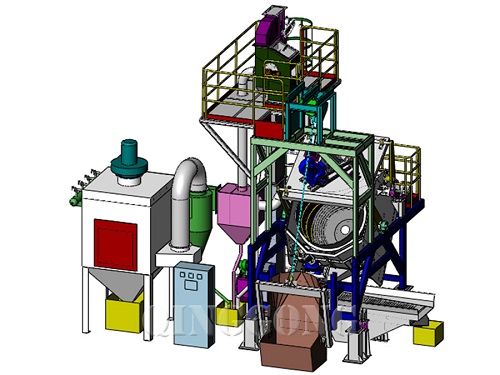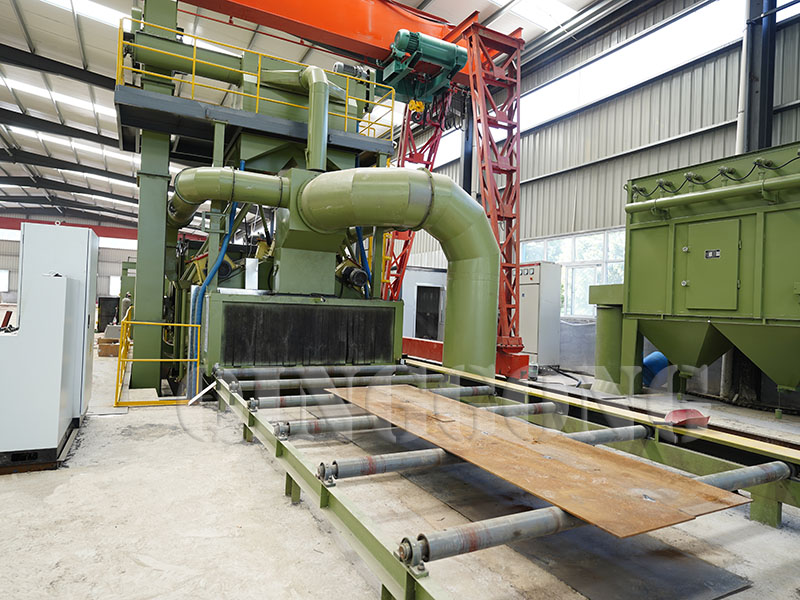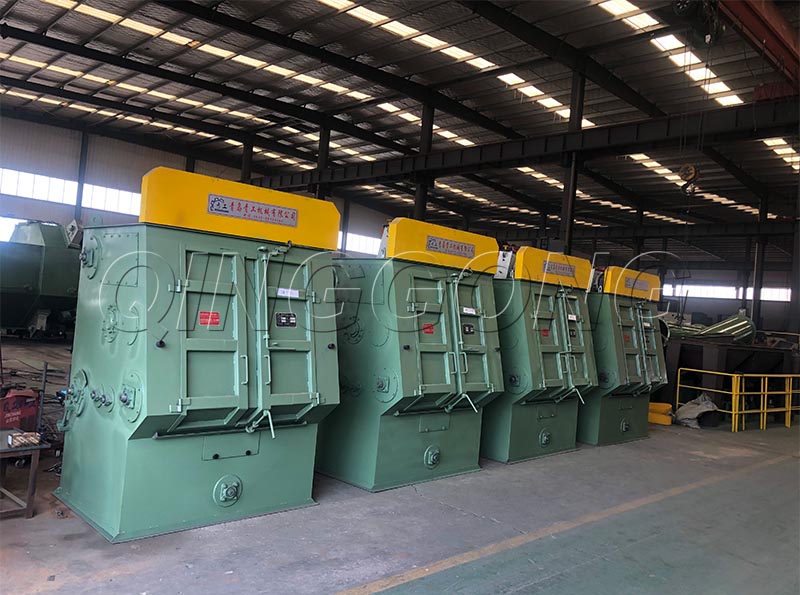Understanding Abrasive Blasting: What Is It and How Does It Work?
Abrasive blasting, also known as sandblasting, is a technique used to clean, smooth, or shape a surface by forcibly propelling abrasive materials against it. This process is commonly used in sandblasting rooms, which are specially designed-areas where abrasive blasting can be carried out safely and efficiently.
In abrasive blasting, a blasting machine or pressure vessel is used to propel abrasive materials such as sand, glass beads, steel shot, or aluminum oxide at high speeds onto the surface being treated. The abrasive material is propelled using compressed air or water, and the force of the abrasive particles hitting the surface removes contaminants, rust, paint, or other unwanted coatings.
Sandblasting room is designed to contain the abrasive material and prevent it from spreading to other areas. The room is typically lined with rubber or polyurethane to prevent the abrasive material from damaging the walls or floor. Air filters and ventilation systems are also used to remove the dust and debris created during the blasting process.
The operator wears protective gear such as a respirator, gloves, and eye protection to prevent exposure to the abrasive material and dust. The operator controls the blasting nozzle and directs the abrasive material to the desired area of the surface being treated.
Abrasive blasting can be used on a variety of surfaces including metal, concrete, brick, and wood. It is commonly used in industrial settings for cleaning and preparing surfaces for painting or coating. It is also used for surface restoration, such as removing graffiti or restoring historical buildings.
The Benefits of Abrasive Blasting: Why It's a Popular Surface Preparation Method
Abrasive blasting, also known as sandblasting, is a process that involves propelling abrasive materials at high speeds against a surface to clean, roughen, or shape it. The abrasive material used can vary depending on the application, but some common materials include sand, glass beads, aluminum oxide, and steel grit.
Here are some benefits of abrasive blasting:
Efficient surface preparation: Abrasive blasting can quickly and efficiently remove surface contaminants, such as rust, paint, and dirt, from a variety of surfaces. This process can prepare the surface for the next step, whether it's painting, coating, or welding.
Versatility: Abrasive blasting can be used on a variety of materials, including metal, concrete, brick, and wood. This makes it a versatile surface preparation method that can be used in many different industries, from automotive to construction.
Cost-effective: Abrasive blasting is a cost-effective method of surface preparation compared to other methods, such as chemical stripping or grinding. It can remove surface contaminants in one step, which saves time and money.
Environmentally friendly: Abrasive blasting can be environmentally friendly if the abrasive material used is eco-friendly, such as crushed glass or walnut shells. It also produces less dust and waste than other methods, making it a cleaner option.
Improved surface adhesion: Abrasive blasting creates a rough surface that improves adhesion for paint or coatings, ensuring better and longer-lasting finishes.
Overall, abrasive blasting is a popular and effective surface preparation method with many benefits. It is versatile, cost-effective, and environmentally friendly, making it a preferred choice for many industries.
Types of Abrasives Used in Abrasive Blasting and When to Use Them
Abrasive blasting, also known as sandblasting, is a process used to clean, polish, or prepare surfaces by forcefully propelling a stream of abrasive material against the surface under high pressure. Sand blasting room is specifically designed to contain the abrasive materials and prevent them from escaping into the surrounding environment.There are various types of abrasives used in abrasive blasting, each with unique properties and advantages. In this answer, we will discuss some common types of abrasives and when to use them.
Sand: Sand is the most commonly used abrasive in abrasive blasting. It is inexpensive and readily available. Sandblasting with sand is ideal for removing rust, paint, and scale from metal surfaces. However, sandblasting with sand can cause lung damage if proper protective gear is not worn, and it is also not recommended for use on delicate surfaces.
Steel Grit: Steel grit is a durable abrasive that is commonly used for cleaning and preparing steel surfaces. It is made by crushing steel shot into angular particles. Steel grit is ideal for removing coatings, scale, and rust from steel surfaces. It is also effective in creating a surface profile that allows for better coating adhesion.
Glass Beads: Glass beads are a popular abrasive for blasting delicate surfaces such as aluminum, stainless steel, and plastics. They are spherical in shape and do not contain any free silica, making them safe to use. Glass beads are ideal for removing surface contamination and producing a smooth, satin finish on a surface.
Aluminum Oxide: Aluminum oxide is a versatile abrasive that can be used on a variety of surfaces, including metal, wood, and plastic. It is a hard, fast-cutting abrasive that is ideal for removing heavy coatings, paint, and rust. It is also effective in creating a profile on a surface that allows for better coating adhesion.
Walnut Shells: Walnut shells are a natural, biodegradable abrasive that is ideal for blasting delicate surfaces. They are non-toxic and non-abrasive, making them safe to use. Walnut shells are effective in removing surface contamination and coatings from surfaces without damaging the substrate.
Plastic Media: Plastic media is a non-abrasive, soft media that is ideal for blasting delicate surfaces such as fiberglass, aluminum, and plastics. It is made from polyester and is reusable. Plastic media is effective in removing coatings, dirt, and grime from surfaces without damaging the substrate.
In conclusion, the choice of abrasive material for abrasive blasting depends on the type of surface being blasted, the type of coating or contamination being removed, and the desired finish. It is important to choose the right abrasive material for the job to achieve the desired results and ensure worker safety.
Safety Considerations for Abrasive Blasting: Protecting Workers and the Environment
Abrasive blasting, also known as sandblasting, is a process that can be hazardous to workers if proper safety measures are not taken. In addition to worker safety, abrasive blasting can also have negative impacts on the environment if not properly managed. In this answer, we will discuss some important safety considerations for abrasive blasting to protect workers and the environment.
Personal Protective Equipment: Workers must wear appropriate personal protective equipment (PPE) when performing abrasive blasting. This includes a respirator to protect against inhalation of airborne dust and abrasive particles, eye and face protection, hearing protection, and protective clothing. The use of PPE can reduce the risk of respiratory problems, hearing loss, and eye injuries.
Engineering Controls: Engineering controls such as local exhaust ventilation (LEV) and dust collectors can be used to capture airborne dust and abrasive particles, reducing the amount of dust that workers are exposed to. It is important to properly maintain and clean these systems to ensure they are working effectively.
Training: Workers should receive appropriate training on how to properly use abrasive blasting equipment, including how to use PPE, how to properly set up and operate the equipment, and how to properly clean up after blasting. Workers should also be trained on the potential hazards associated with abrasive blasting, including the risk of respiratory problems and eye injuries.
Environmental Considerations: Abrasive blasting can produce hazardous waste, including spent abrasive and blasting debris. It is important to properly manage and dispose of these materials to prevent environmental contamination. This may include collecting and disposing of spent abrasive and debris in a landfill, or recycling the abrasive material.
Permitting and Compliance: Depending on the location and type of abrasive blasting being performed, a permit may be required. It is important to obtain any necessary permits and comply with all applicable regulations and guidelines to protect the environment and ensure worker safety.
Choosing the Right Abrasive Blasting Equipment: Factors to Consider
Choosing the right abrasive blasting equipment is important to ensure that the blasting process is efficient, effective, and safe. There are various factors to consider when selecting abrasive blasting equipment, including the type of surface being blasted, the type of abrasive being used, and the size and scope of the project. In this answer, we will discuss some important factors to consider when choosing abrasive blasting equipment.
Size of Project: The size and scope of the project will also impact the choice of blasting equipment. Small projects may only require handheld equipment, while larger projects may require automated equipment or mobile blasting systems. It is important to choose equipment that is appropriate for the size and scope of the project to ensure efficient and effective blasting.
Safety Considerations: Worker safety is always a top priority when selecting abrasive blasting equipment. It is important to choose equipment that is designed to minimize the risk of injury to workers, such as equipment with appropriate guarding and safety interlocks. It is also important to choose equipment that is designed to minimize the risk of environmental harm, such as equipment with dust collection and containment systems.
Maintenance and Service: Abrasive blasting equipment requires regular maintenance and service to ensure optimal performance and longevity. It is important to choose equipment that is easy to maintain and service, and to choose a supplier that offers comprehensive support and service.
 EN
EN
 fr
fr  de
de  es
es  it
it  ru
ru  pt
pt  ar
ar  th
th  pl
pl  ro
ro 


